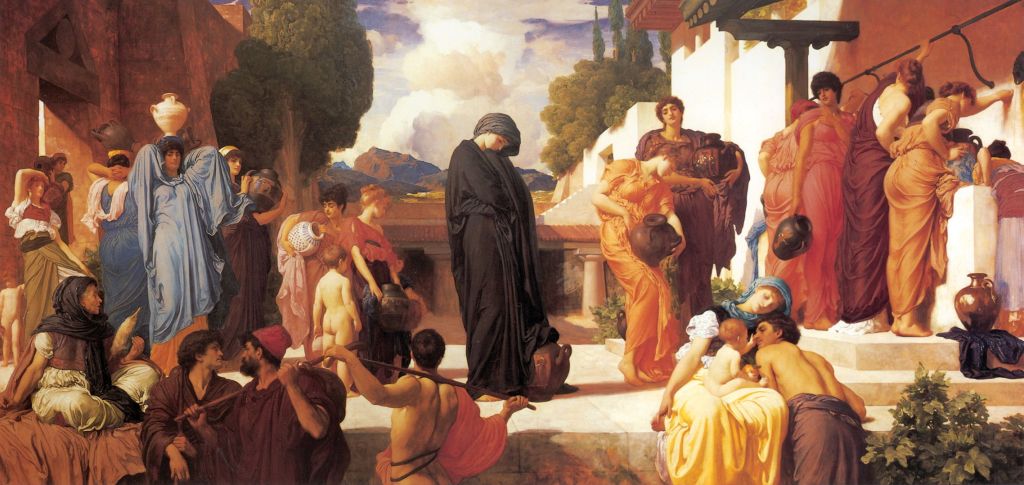The ultimate purpose of the Trojan War as far as Zeus was concerned was to reduce the number of mortal humans, something that had worked well over the ten years of the war. In its final stages the god was hoping for the sacking of the city to be accompanied by mass killing. The Greeks had to be more focussed, and concentrate on the physical destruction of the city, and making off with as much booty as they could carry home.

This painting by Gillis van Valckenborch of The Sack of Troy from around 1600 is typical of the many atmospheric works showing this event on a grand scale. A few notable Trojans did make their escape, though.

Adam Elsheimer’s painting of The Burning of Troy (c 1600-01) shows in the left foreground Aeneas, one of Troy’s surviving warriors, carrying his aged father Anchises piggyback, with his young son Ascanius and his wife Creusa to the right. Elsheimer’s backdrop of the burning city includes the Trojan Horse, to the left of the upper centre, and hints with subtlety at the scale of the tragedy taking place.
The next task was for the Greek forces to withdraw to their ships with all their prizes, including Trojan women, so they could set sail for home. As the Greek ships prepared to depart, Hecuba, Priam’s widow, was the last to board. Her youngest son, Polydorus, was secretly in the care of King Polymestor in Thrace, who was paid a great sum to protect him. With Troy destroyed and that source of income lost, Polymestor slit the child’s throat, and threw his body into the sea.
When caught in gales, the Greek fleet took shelter off the coast of Thrace, once again waiting for more favourable winds. While there, the ghost of Achilles appeared and demanded that Hecuba’s daughter be sacrificed in appeasement.
As with Iphigenia’s sacrifice ten years before, it was now the turn of Hecuba’s daughter Polyxena to be sacrificed to secure good weather. She was taken from the arms of her mother, whom she was comforting, and put before the altar where Neoptolemus, son of Achilles, was standing ready with his knife. Polyxena pleaded eloquently for her body to be given to her mother without the requirement of a ransom. Her speech even brought the priest to tears. Neverthless, he thrust the knife into her breast, and she fell to her knees, still resolute, but dead.
The Trojan women mourned her, and cared for her body, so that her mother could embrace her in final farewell. Hecuba responded with a long speech of lament.

Merry-Joseph Blondel’s fine painting of Hecuba and Polyxena, from after 1814, sets the scene. Hecuba, the older woman, appears to have fainted, presumably at the announcement of Polyxena’s imminent sacrifice, with her daughter kneeling at her feet.

Several paintings show the sacrifice of Polyxena, of which Charles Le Brun’s from 1647 is arguably the finest, and in superb condition. Polyxena is being led to the altar as Hecuba tries to hold her back. Behind Polyxena is the same Neoptolemus who had possibly thrown Astyanax to his death, threatening to kill her where she was.

Giovanni Francesco Romanelli’s The Sacrifice of Polyxena, from about the same time, shows the moment that the priest is about to sink his knife into the woman’s breast. A young assistant, their head averted, kneels ready with a large bowl to catch the sacrificial blood.
Priam’s widow then walked down to the beach for a jar of seawater, and stumbled across her son Polydorus’ body. She was initially struck dumb, and froze like a rock with the shock. As that subsided, her wrath grew. She made her way to meet with Polymestor, on the pretext of wanting to show him some hidden gold. He immediately started to lie to her, throwing her into a rage. She dug out his eyes with her fingers, causing the Thracians to attack her with stones. According to Ovid, Hecuba was transformed into a dog, and the place named Cynossema, the dog’s tomb.

The Vengeance of Hecuba is a magnificent Macao tapestry from the seventeenth century, showing Hecuba and three other women sealing Polymestor’s fate for his murder of Polydorus. Hecuba is poking his eyes out, as the others swing long wooden clubs at him.

Giuseppe Crespi probably painted his version of Hecuba kills Polymestor in the early eighteenth century. His skilful composition makes it a chilling but carefully implicit image, as a woman associate holds the king down, and Hecuba reaches up to remove his eyes.
I cannot find any subsequent paintings showing these terrible stories, but there is one very moving painting which brings them to a close.

Frederic, Lord Leighton’s Captive Andromache (c 1886) shows Hector’s widow, and Astyanax’s mother, swathed in black, queueing for water among other Trojan prisoners. She appears lost in thought.
At this point, the epics divide to cover subsequent events. Homer’s Odyssey gives an account of the wanderings of the Greek hero Odysseus, who had led the commando force inside the wooden horse, while Virgil’s Aeneid tells the story of the Trojan refugee Aeneas, as he made his way to found a new empire in Italy.
In the next episode we’ll start with the Odyssey.

